Some years ago, at a Romantic Novelists’ Association conference, I heard Professor Jenny Hartley give a talk on popular Women’s Fiction – she was researching it at the time. At the end, after the questions, she said, ‘I’d now like to ask you a question: how many of you have read Katherine by Anya Seton?’
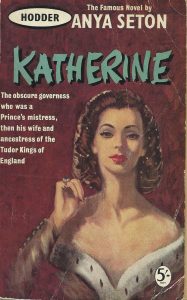
Cover of ‘Katherine’ by Anya Seton (1961)
A forest of hands shot up. The entire conference had read it. I myself read it as a teenager and loved it. First published in 1954, it’s the story of a herald’s daughter, Katherine Swynford, who was first the mistress and then the third wife of John of Gaunt, a marriage which scandalized all Europe. It is one of English History’s great love stories and it truly changed the course of history; for Katherine became the ancestor of the Tudors and thus of Queen Elizabeth II.
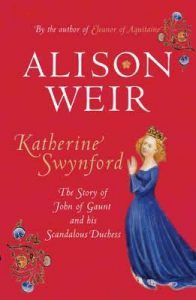
Alison Weir’s biography: ‘Katherine Swynford’
More recently, at a Historical Novel Society conference, the historian Alison Weir spoke about her new biography of Katherine Swynford. She was aware that most of the audience had probably read Anya Seton’s book, and she began by telling us she, too, had learnt of Katherine’s existence from Katherine, and paid a graceful tribute to Anya Seton’s research and the power of her story-telling. Of course, research had moved on, and there was now more of John and Katherine’s story to tell.
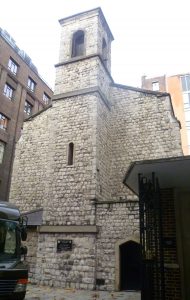
The Queen’s Chapel of the Savoy
So, when the opportunity came up to visit the Queen’s Chapel of the Savoy, standing on the very site where John of Gaunt had built the Savoy Palace which features largely in Katherine, (who can forget the love scene in the Avalon Chamber?) I jumped at it. I knew that the Savoy Palace had been ransacked and burnt during the Peasant’s Revolt in 1381 but I assumed that the chapel must have survived.
Before the tour, our guide, Squadron Leader Thomas Leyland, asked me if I knew anything about the Chapel. I said, ‘Yes, wasn’t it part of John of Gaunt’s Savoy Palace?’ He gave a sigh and said, ‘I don’t know how many times people have asked me that question – dozens of times. The answer’s “No.”’

John of Gaunt: thought to be a 17th century copy of an earlier portrait
I thought, and I bet all of them were female, had read Anya Seton’s Katherine, and were in love with that golden-haired, sexy Plantagenet, John of Gaunt.
Having said all this, and despite my initial disappointment, the Queen’s Chapel of the Savoy proved to be both interesting and beautiful. The Savoy Palace remained a burnt-out ruin until the site was cleared on the orders of Henry VII (John and Katherine’s great-great grandson) in order to build a charitable foundation for a hundred ‘pour and nedie’ men in 1515. It included the Savoy Chapel.
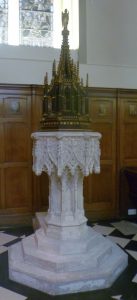
The elegant 19th century ‘Gothic’ font
Two hundred years of subsequent neglect (it was never properly endowed) followed. In the early 19th century, the most of it was demolished and in 1820-21, the ruinous chapel was restored by Sir Robert Smirke, architect of the British Museum. Only the east, west and north walls and the perpendicular windows of Henry VII’s chapel survive. (Unusually, the chapel is orientated north-south rather than the usual east-west.) The building was engulfed by another fire in 1864. The chapel we see today is the result of sympathetic post-fire reconstruction by Sir Robert’s brother, Sidney; I think he did a good job.
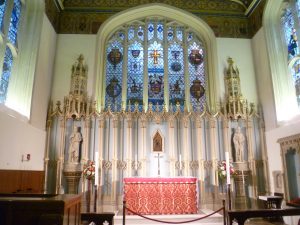
The Savoy Chapel, looking towards the altar
The early 16th century perpendicular style is a sort of airy Gothic which I find very attractive. I love the view towards the high altar with the delicate 19th century Gothic-style reredos behind the altar.

The ceiling
The wonderful blue and gold ceiling is believed to be a copy of the original Tudor building and it’s decorated with shields within quatrefoils with the coats of arms of various dukes of Lancaster associated with the Savoy, including, of course, John of Gaunt’s, with its gold on red Plantagenet lions quartered with the gold on blue fleur de lys of France.
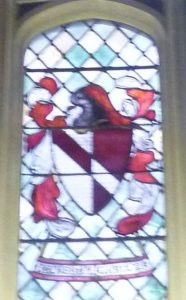
Geoffrey Chaucer’s shield: stained glass
To my pleasure I realized that there were, in fact, a couple of small reminders of John and Katherine’s story. As well as John’s coat of arms on the ceiling, one of the chapel windows depicts Geoffrey Chaucer’s coat of arms. Katherine had known him well; he had married her sister, Philippa, who was lady-in-waiting to Queen Philippa, Edward III’s wife, and John of Gaunt’s mother.
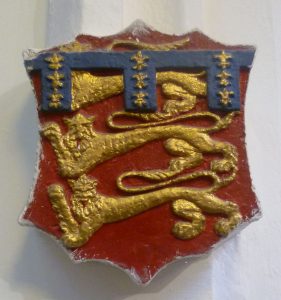
Plantagenet shield
The chapel itself is, and always had been, a private chapel of the Sovereign, and thus independent of Church of England jurisdiction. Like Westminster Abbey, it is a ‘royal peculiar’. It is an integral part of the royal Duchy of Lancaster and its coat of arms is everywhere.

Princess Anne’s banner with her coat of arms in front of the organ
Since 1937, it had been the chapel of the Royal Victorian Order, an order which is solely in the gift of the sovereign for exceptional service to the crown. Princess Anne is the current Grand Master of the R.V.O. and her banner hangs from the chapel wall.
It is very much a working chapel with regular services and a fine men and boys’ choir which the public are welcome to attend. There are also special services for members of the Royal Victorian Order, for examples, weddings and memorial services, where members of the Royal Family may be present.
It’s a lovely and tranquil place to visit.
Elizabeth Hawksley
Please share this page...
That is so fascinating. I didn’t even know that it existed. Will definitely now seek it out.
Thank you for dropping by, Jenny. I don’t think you’ll be disappointed by the Savoy Chapel. It’s unusual and has a lovely atmosphere.
Excellent. I , too, was inspired by Katherine. I have to say though that The Savoy Palace was built in the mid Thirteenth century , not by John of Gaunt at all, though he may have added to it, but by Peter of Savoy , one of Queen Eleanor of Provence’s relatives who flooded court during the reign of Henry III.
Thank you for your interesting comments, Carol. I’m delighted you enjoyed the post. The Savoy Chapel guide book mentions Peter of Savoy but says, ‘Peter’s ownership of the manor was not long,’ and adds that, ‘A royal palace was built on the Savoy estate by Edmund’s grandson (John of Gaunt) in the middle of the fourteenth century, though its lifetime was short.’ My guess is that we don’t actually know who did what and when in much detail.